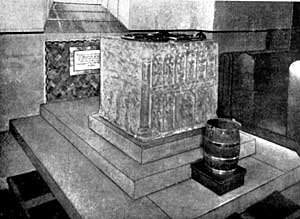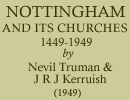Lenton has four churches under one vicar: Holy Trinity, The Priory church, St. Barnabas', Lenton Abbey, and St. Marys', Wollaton Park.

The font at Lenton.
The Parish Church, built when the Priory Church became too small, has a reredos of green and gold glazed tiles with a figure of Our Lord in the centre, but its one notable feature is the well-known Norman font illustrated in so many architectural books. It is square and covered with carvings from top to bottom. On the dissolution of the monastery it was probably saved and placed in the old parish church which stood on the site of the present Priory Church. It became alienated and used as a garden ornament for the Stretton family who returned it to its rightful home when the present parish church was built in 1842. Its decoration is not easy to follow: on the east face there is a row of cherubim and seraphim at the top and the Evangelists below, with a central panel showing the Baptism of Our Lord by St. John. On the south is seen the Crucifixion, with censing angels on either side of the cross. The Roman soldier pierces Christ's side, and the soul of the penitent thief appears as a small figure coming out of the mouth and soaring upwards. The destination of the soul of the impenitent thief is in the contrary direction, and a large dragon (which represents the mouth of hell according to the medieval craftsmen) awaits it. On the west we have four panels: the first being the Resurrection of Christ, who is blessing; the angel sits beside the rolled-away stone. The second gives a view of the Entombment and Resurrection. A Roman soldier puts on the coffin lid, under which is the swathed figure of the Crucified, with two angels on the left. The third depicts the Marys going to the sepulchre on Easter morning. The fourth portrays the Sepulchre guarded by the angel on the right. It is considered that this picture of the Sepulchre, in the actual form in which it existed before its destruction by the Moslems during the Crusades, was carved by someone who had visited the Holy Land. The north side is the plainest, having merely an ornate cross upon it. The date is about 1100.
The Priory Church is on the site of the infirmary chapel of the monastery, and the chancel walls are the original ones. On the Dissolution the parishioners could no longer be catered for in the Priory and this chapel was taken over, a larger nave being added in Tudor style. When the new parish church was made the chapel was partly demolished, but forty years later it was rebuilt for use as a district chapel. There are a few old relics such as the piscia, a scratch dial, and a thirteenth-century coffin lid now behind the organ.
St. Barnabas' on the miscalled "Abbey Estate" (why have the City Fathers falsified history here?) is a small building in modernist style into which a little colour has been happily introduced. As at St. Mary's, Wollaton Park, its architect was Mr. Cecil Howitt.
St. Mary's, Wollaton Park, including its Parsonage and Church Hall together with furnishing, was the gift of Mr. W. G. Player and is a more ambitious building. It has some clever architectural devices not recognisable by the untrained eye, e.g. the absence of visible rain gutters and down spouts, and the apparent lack of support for the high walls. It shows the influence of Sir Giles Scott's Charterhouse Chapel and is an example of an aisleless church which is dignified and even stately.

St John's, Carrington.
St. John's, Carrington, owes its foundation to Mr. Ichabod Wright, of Mapperley Hall, who not only gave the land and largely paid for the church, but also partly endowed it and was its principal designer. A contemporary record of the early beginnings, hand written and leather bound, was presented to him in 1843 and now belongs to the church. Its value is great, and it is to be wished that more churches would keep such records and scrap books of news-cuttings and the like for future use. This one is illustrated by four really charming ink drawings, most delicately and capably sketched. The drawing of the people in front of the Church School is indeed masterly and full of character. There is a lame beggar with crutch and dog, a panniered donkey fallen down whom his master threatens to beat while a stranger is pleading for mercy, and two impish boys who creep behind an old woman, bent on playing some trick on her. Unfortunately the work is too minute for reproduction.
Carrington is called Carrington for the following reason. Mr. Wright bought land in about 1825 as an investment from the first Lord Carrington (Robert Smith the banker, and financial adviser to Pitt the Prime Minister) and decided to name it after the vendor. Building development was so rapid that in ten vears the population had become 6,500 and a National Church School was built for £700, mostly given by the Wrights, and a Rev. Dr. Bosworth took spiritual charge of the district, using the school as a church.
In 1841 the foundation stone of the present church was laid by Mr. Wright and two years later it was consecrated by Dr. Kaye, Bishop of Lincoln. Most of the fittings were given by the Wright family. The font is a copy of the well-known Early English one at Barnack and was given by the then Dean of Lichfield (the Hon. Dr. Howard, the Founder's son in law). Though the aisleless building had Early English windows, Mr. Wright did not scruple to make the eastern one Decorated and its tracery is by no means bad. He put in a rather ambitious hammer-beam roof of very black wood, but it is too thin to be effective. A chancel was added between 1866 and 1877 and the old easy window re-used.
In 1922 a large north aisle, with chapel, was added, to the design of Mr. Heazell. In 1949 a new organ was obtained which was formerly in a private house at Radcliffe and the opportunity was taken of clearing the east end of the south nave from the unsightly organ hitherto in this place.
St. Mary's and All Souls', Bulwell, occupies the site of the medieval church of which no trace remains except some window tracery. It has probably been a centre of worship since very early times, though 1134 is accepted as the year of foundation. Pentecostal offerings were made in 1171 and there is mention of advowsons in 1207. The first church disappeared in favour of a new one in the tifteenth century. This church, which stood some sixty yards north of the present one, became too small owing to growing industrialisation and in 1850 an entirely new church was built. One regrets that the old one was not retained, even though enlarged, but at that time antiquarian and artistic considerations did not receive much care.
The lord of the manor and patron (the Rev. Alfred Padley) provided half the cost of £3,000. Subsequently the Hardy family became patrons and lords of the manor, their most renowned member being the Rev. T. B. Hardy who gained the V.C as a chaplain in the 1914 war. The Bishop is now patron.
The Hardys gave the alabaster reredos (said to be one of the finest of its sort in the country) and the alabaster panelling in the sanctuary. The whole of this work is Italian, and the reredos was exhibited in the Pans Salon on its way from Italy to England. A high altar of Derbyshire alabaster was given in 1945 and the north aisle chapel made in the following year.
The church with its tower, standing on a hill just before you reach Bulwell market, dominates that part of the city. It is the parent church of St. John's, Bulwell.
The first recorded Rector is Henry Medicus (1234) but, apart from two others in the thirteenth and fourteenth centuries, the roll of rectors has no other names until 1650, from which time it is continuous.
The parish is one of the most thickly-populated parts of the city, containing many Victorian streets, though it also has the rather better type of housing estates which were possible just before the recent war.
Christ Church, Cinderhill. A glimpse of an obsolete world seems to come to us when we read that this church was built "for the coal miners of Thomas North, Esq., of Basford Hall". There is an air of ownership about it which we would be afraid of using now. Yet this country gentleman, with his sense of proprietorship, had also a strong feeling of duty to his employees. "Mr. North", runs the Illustrated London News in 1856, "is prosecuting the development of a great coalfield of from 8,000 to 10,000 acres in extent, and is building squares of cottages, and laying out allotments for the comfort and convenience of his miners. . . . One need struck this great coalowner as essential to be supplied above all others, and that was church accommodation."
The Duke of Newcastle gave the site and Mr. T. C. Hine was the architect. He was something of an antiquarian and wrote a history of Nottingham Castle. The writer of the London News article becomes quite lyrical about the "perfect little gem of a building" (costing £2,000) and its situation amidst a beautiful clump of trees, at the angle of Derby Road opposite the finely wooded residence of Mr. North". Heads of sovereigns form corbels to the outer walls, and care was expended on the roofs of collar-beamed rafters and arched braces. The style purported to be fourteenth century Decorated. Even in these over-built days there is still a lingering air of the country about the place, part of Basford Park providing a welcome breathing space.
St. Saviour's began its history over a boot shop next to Mellor's factory in Arkwright Street. It was there that the members of a Mission from St. Mary's (in which parish Arkwright Street then was) used to meet. The Mission grew and prospered and in 1863 the foundation stone of a new church was laid. This church, built in Decorated Gothic, was opened for worship in 1864. The scene in the Meadows was very different in those days. From the church to the old Trent Bridge was waste land, the hunting-ground of local sportsmen. Opposite the church were gardens. From the church to Kirkewhite Street were low-lying fields, and the town was reached by a level-crossing over the railway where now the Midland Station stands. In the spring and autumn the fields were a carpet of wild flowers. St. Saviour's now serves a large working-class area of cobble stone streets round about Arkwright Street in this well-known industrial part of Nottingham.
